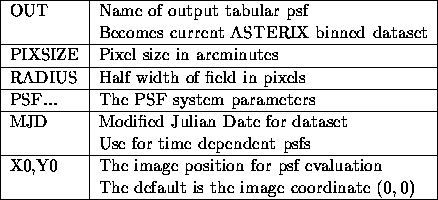

CREPSF generates a two dimensional binned dataset containing a psf of the user's choice. The user controls the bin and image sizes, and the psf to be used. At the moment, this application cannot produce tabular datasets with spatially varying psfs.
There are two main uses of CREPSF. The first is as a method of speeding up multiple invocations of programs using the same psf, which is slow to compute. For example, the BSUB application requires a psf template which enclosed 90% to 95% of the psf energy. At the WFC survey image size of 1 arcminute this required a psf more than 30 pixels across, which took of order 30 seconds to compute. The following sequence of commands generated a psf which could be used for both BSUB and PSS,
> CREPSF OUT=PSF_S1A PSF=WFC ~ ; Create tabular psf
AUX=S1A PIXSIZE=1 RADIUS=15 \
> BSUB IMAGE PSF=TABULAR ~ ; Invoke background subtraction
MASK=PSF_S1A ... ; using tabular psf
The second use is in searching or parameterising extended sources.
As mentioned in Section 4.9 PSS is limited in
its ability to search for very extended sources. An alternative to
using PSS source extension testing mechanism (which can only be used
in SEARCH and PARAM modes anyway) is to use CREPSF
and (say) SMOOTH to create a test source profile. The example below
creates the extended spread function EXTEN_SF by convolving
the point response produced by CREPSF with a top-hat function (the
source's supposed intrinsic surface brightness distribution),
> CREPSF OUT=POINT_SF PSF=WFC ~ ; Create tabular instrument psf
AUX=S1A PIXSIZE=1 RADIUS=15 \
> SMOOTH POINT_SF EXTEN_SF ~ ; Smooth with top-hat
MSK_MASK=TOP MSK_WIDTH=5 ..
> PSS ... MODE=UPLIM PSF=TABULAR ~ ; Upper limit using extended
MASK=EXTEN_SF ; spread function
and uses it to find the upper limit to the source intensity using PSS.
Note that it is important that the normalisation of the psf remains correct, ie. sum of the values in the array would be unity if it was big enough. Failure to ensure this will result in incorrect results out of most programs using the ASTERIX psf system.
Once the tabular psf has been created it can be used in any ASTERIX application which uses the psf system, including the event simulator EVSIM. This is useful as perhaps the most reliable method of measuring the significance of extended source features is by testing the processing method on simulated data, with and without the supposed feature.